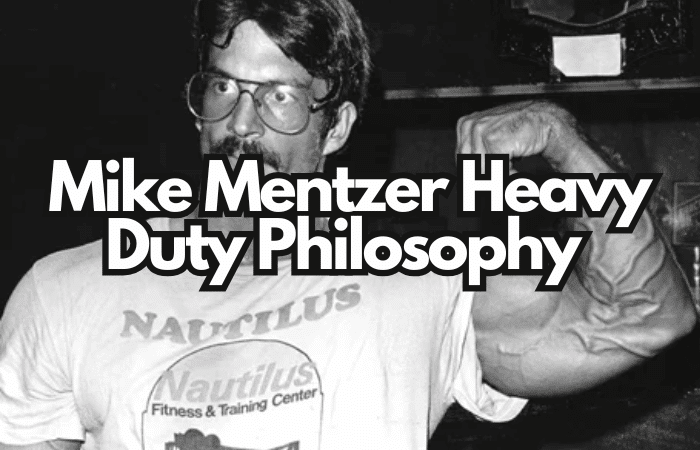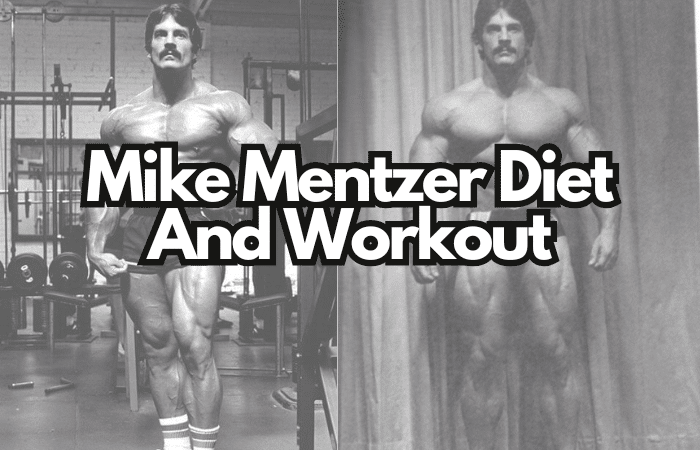Mike Mentzer wasn’t just another bodybuilder chasing trophies under the bright lights of the Olympia stage. He was a thinker, a contrarian, and a man determined to reshape the very philosophy of training. With his chiselled physique, sharp intellect, and uncompromising intensity. To his followers, he was a visionary; to his critics, a heretic.
Enough with the poetry already, and lets take us back to the golden era of bodybuilding. I'll tell you about Mike Mentzer's workout routine, his diet and how you can adapt it to your daily trips to the gym!
Quick Facts – Mike Mentzer
| Full Name | Mike Mentzer |
|---|---|
| Birth | Ephrata, Pennsylvania, United States, November 15, 1951 |
| Death | Los Angeles, California, United States, June 10, 2001 |
| Height | 5 ft 8 in (173 cm) |
| Weight (Competition) | 225 lb (102 kg) |
| Weight (Off-Season) | ~250 lb (113 kg) |
| Current Home | Deceased |
| Occupation | Professional Bodybuilder, Author, Fitness Theorist |
| Known For | “Heavy Duty” Training Philosophy |
| Net Worth | Estimated $1–2 million at the time of his passing |
| Family | Brother: Ray Mentzer (IFBB Professional Bodybuilder) |
| Notable Achievement | 1979 Mr. Olympia (Heavyweight Champion), First Bodybuilder to Receive a Perfect 300 Score (1978 Mr. Universe) |
What was Mike Mentzer’s Workout Philosophy?
Mike Mentzer’s workout philosophy was nothing short of revolutionary. At a time when most bodybuilders were grinding away in the gym for hours each day (often training twice daily), Mentzer stood apart. He argued that more wasn’t necessarily better and, in fact, he believed it was worse. His system, known as Heavy Duty, was rooted in the idea that maximum muscle growth came not from endless volume, but from short, brutally intense sessions followed by generous recovery.
Where Arnold Schwarzenegger thrived on marathon workouts with countless sets, Mentzer dismissed such practices as inefficient and even counterproductive. Where contemporaries like Frank Zane sculpted their physiques through precision and consistency in higher-volume training, Mentzer believed in logic and science, citing principles of stress, recovery, and adaptation.
He championed the idea that lifting should be treated with the precision of an exact science rather than the guesswork of tradition.
To Mentzer, a set taken to absolute muscular failure was the true catalyst for growth. Once that point was reached, further sets were not only unnecessary but even they risked overtraining. Instead of five or six days in the gym, his disciples often found themselves training only two or three times per week, yet achieving gains that rivalled or even surpassed their peers.
Mentzer’s philosophy wasn’t just about building muscle; it was about efficiency, discipline, and questioning dogma. In many ways, he was the thinking man’s bodybuilder: an athlete who dared to apply reason where others relied on ritual.

- Low Volume, High Intensity: Few sets, each pushed to absolute muscular failure.
- Brief Workouts: Sessions often lasted less than 45 minutes.
- Infrequent Training: 2–3 workouts per week, emphasizing recovery.
- Science Over Tradition: Grounded in logic, not just “what everyone else was doing.”
- First Perfect Score in Bodybuilding: His methods proved their worth onstage with unprecedented results.
- Influenced Future Thinkers: Mentzer’s ideas shaped later training philosophies, including high-intensity training advocates like Dorian Yates.
Mike Mentzer’s Heavy Duty Workout Routine
You might think it doesn’t look like much, but trust me when I say it was more than enough. Mike Mentzer wasn’t known for the length of his workouts or the number of exercises he performed, but the intensity with which he executed them. Each set wasn’t just a casual effort to move weight from point A to point B; it was an all-out assault on the muscle, driven to the very edge of human capacity.
| Day | Muscle Groups | Exercises | Notes |
|---|---|---|---|
| Day 1 | Chest & Back | – Incline Barbell Press (2 set to failure) – Dips (weighted, 1-2 set to failure) – Nautilus Pullover (1-2 set to failure) – Barbell Row (1-2 set to failure) | Focus on maximum intensity, slow controlled reps, no more than 4 total sets. |
| Day 2 | Rest | — | Recovery is as important as the workout itself. |
| Day 3 | Legs | – Leg Extension (2 set to failure, pre-exhaust) – Leg Press (1-2 set to failure) – Calf Raises (1-2 set to failure) | Ray Mentzer often spotted him on leg press to ensure complete effort. |
| Day 4 | Rest | — | Full rest to allow supercompensation and growth. |
| Day 5 | Shoulders & Arms | – Overhead Press (2 set to failure) – Lateral Raises (1-2 set to failure) – Barbell Curl (1-2 set to failure) – Triceps Pushdown (1-2 set to failure) | Always trained with strict form, often finishing with forced reps. |
| Day 6–7 | Rest | — | Full recovery before restarting cycle. |
Low volume and Spotting
One of the defining features of Mike Mentzer’s approach was his unwavering commitment to low-volume training, which necessitated the absolute requirement of a reliable training partner. Because Mentzer believed in taking every set to the point of total muscular failure, he could not have executed his system without the help of a spotter. That spotter, more often than not, was his younger brother and fellow IFBB professional bodybuilder, Ray Mentzer.
Their partnership in the gym was legendary. Mike would drive through a set with ferocious intensity, grinding out each rep until his body refused to move another inch. At that precise breaking point, Ray would step in. Not to take over, but to provide just enough assistance to keep the movement alive. These “forced reps” and “negatives” were at the core of Mike’s Heavy Duty method, pushing the muscles far past what traditional training could ever achieve.
What About The Warm Up?
For Mike Mentzer, warm-ups were simple and to the point. He wasn’t interested in wasting energy on endless prep sets; his goal was to save everything for that one, all-out effort. He’d do one or two light sets of the exercise at hand, just enough to get blood flowing and joints ready. After that, the weight went up, the focus sharpened, and he attacked the working set with maximum intensity.
No elaborate routines, no long stretches of “getting ready.” Just a quick primer, then straight into battle.
Mike Mentzer’s Diet: Balanced, Practical, Effective
Mike Mentzer believed, just like myself, that diet should be simple, sustainable, and built on logic rather than fads. Just as he approached training with his Heavy Duty philosophy, he applied the same rational mindset to nutrition. For him, food was fuel for performance, recovery, and growth. Not something to overcomplicate or obsess over.
Key Principles
- Balanced meals
Mentzer emphasized eating from all food groups: grains, fruits, dairy, and protein sources. His diet was structured but never rigid to the point of being unrealistic. - Carbohydrates as the foundation
He believed carbohydrates should make up roughly half of daily calories. Muscles need energy to grow, and carbs provided that energy most efficiently. - Protein in moderation
Unlike many of his peers, Mentzer didn’t chase sky-high protein numbers. He argued that since only about a fifth of muscle is made of protein, moderate intake was more than sufficient to support growth. - Simple servings
His guideline was straightforward: four servings each of grains and fruits, and two servings each of dairy and protein every day. - Occasional flexibility
Mentzer wasn’t against the occasional indulgence. A slice of pizza or a bowl of ice cream wasn’t seen as a failure but a part of a realistic, long-term approach to eating. - Calories above all
While macronutrient ratios mattered, he placed more emphasis on total calorie intake, ensuring it supported training and recovery without excess.
Diet Overview
| Aspect | Mentzer’s Approach |
|---|---|
| Macronutrient Ratio | ~50–60% carbohydrates, ~25% protein, ~15% fat |
| Food Group Servings | 4 servings grains + 4 servings fruits + 2 servings dairy + 2 servings protein daily |
| Protein Philosophy | Moderate intake is enough—muscle is not built on protein alone |
| Calorie Focus | Maintain a small surplus; focus on overall energy balance |
| Diet Flexibility | Occasional treats allowed, as long as the foundation remains balanced |
| Sustainability | Simple, long-term nutrition framework without extreme restrictions |
More Profiles
-
Vivi Winkler Bio: Age, Height, Weight, Workout, & Diet!
Viviane Winkler Lourenço, the top Brazilian fitness model, is an exceptional personality. The Vivi Winkler biography is quite inspiring as she went from being an obese child who was bullied in high school to an online sensation with millions of followers. She started her journey from her hometown in 2006, and since then, she has…
-
Eddie Hall Bio: Age, Height, Weight, Career, And More
For many people in the UK, the festive season in December isn’t just for sharing presents, enjoying party food, and watching Christmas films, the festive season also happens to signify the start of the strongman season on the TV. Despite many of the most prestigious Giant’s Live strongman contests taking place in the spring, summer,…
-
Andrei Deiu Bio: Age, Height, Weight, Workout, And More!
Years ago, if you wanted to see bodybuilders compete, you’d be treated to 280 – 300-pound mass monsters posing on stage, with muscles in places that most people don’t even have places. Now, don’t get us wrong, the men’s heavyweight divisions are still very popular, but at the Olympia these days, more and more people…
Final Takeaway
Mike Mentzer proved that bodybuilding doesn’t have to be about living in the gym. He showed the world that brutal intensity beats endless volume, and that recovery is just as important as the work itself.
His philosophy wasn’t for the faint of heart however. It demanded honesty, discipline, and the courage to train harder in one set than most do in ten. If you’re looking for a shortcut or a comfort zone, Heavy Duty isn’t for you. But if you’re willing to push yourself to the breaking point and trust the process, Mentzer’s way can deliver results that most lifters only dream about.
Tips for Training Like Mentzer
- Ditch the junk volume: Stop wasting time with 20 sets per muscle group. Pick a few key lifts and annihilate them.
- Take every set to failure: Not “when it gets tough,” but when your body literally can’t move the weight another inch. That’s where growth happens.
- Get a spotter you trust: Mentzer had Ray. You need someone who can help you squeeze out those last brutal reps safely.
- Recover like it’s your job: If you’re training this hard, you’ve got to rest even harder. Sleep, eat, and give your body time to grow.
- Think, don’t follow: Mentzer wasn’t afraid to question bodybuilding dogma. Don’t just copy routines, understand why they work.






